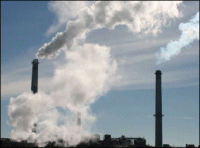Green Horizons
Volume 18, Number 1Winter 2014
The Cloud Factory: MUís Power Plant
By Hank Stelzer
 |
PHOTO BY HANK STELZER |
| The "cloud factory" north (left) and south (right) stacks at work. |
The other morning, as I was taking my neighbor's son to daycare, he looked out the window and exclaimed, "look, Mr. Stelzer, a cloud factory!" Fortunately, traffic was light, so I glanced in the direction of his gaze. And then I saw it. The University of Missouri's combined heat and power (CHP) plant producing a giant 'cloud' from the northern smokestack.
Smokestack, however is a misnomer. It should be called a 'water vapor stack.' The north stack vents the combustion products of the university's new biomass boiler, and the main component of the 'smoke' is water vapor. Woody biomass fed into the boiler is called 'green' or 'wet' and contains about 35 to 40 percent water. When the biomass is burned, the moisture is converted into steam which travels up the stack and into the air. In cold wintry air, the vented water vapor produces a 'cloud.'
No harmful sulfur oxides (SOx) are produced, nitrous oxides (NOx) are removed chemically and particulates (soot) are removed electrostatically inside, before the remaining water vapor is sent up the stack.
The south stack vents the combustion products from four coal-fired boilers that are also co-fired with 15 percent wood chips. Because coal is a drier fuel, its water vapor cloud is much smaller.
The biomass boiler started up in October 2013, after 18 months of construction and six months of testing. The boiler consumes about 21 tons of wood chips every hour, a little less than a semi-trailer load. The heat produces steam in a closed loop system. The high-pressure steam then turns a 15 mw generator to produce electricity. The low-pressure exhaust steam is distributed to about 340 buildings on the 600-acre campus via more than 30 miles of piping where it heats and cools over 13 million square feet. Afterward, the steam, now hot water, returns to the plant for another cycle of the energy loop. The overall thermal efficiency of the plant is 70 percent, more than double the energy efficiency of conventional coal-fired power plants.